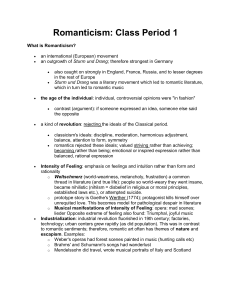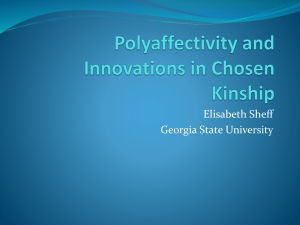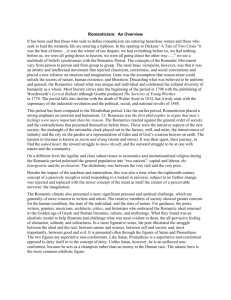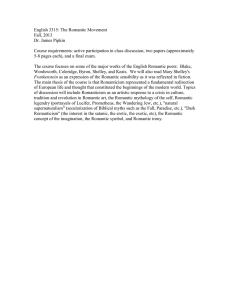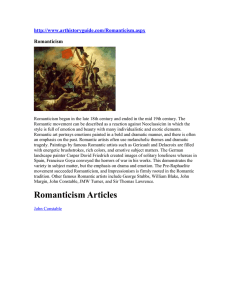The Romantic Romantic death
advertisement
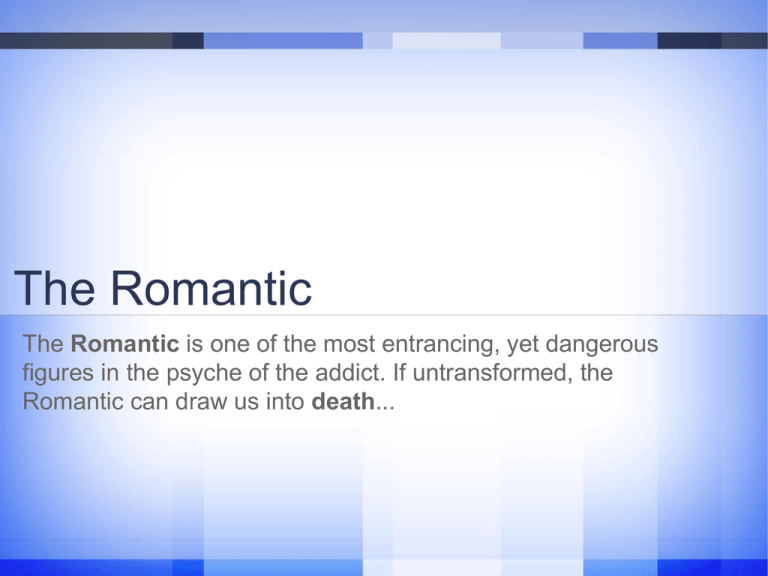
The Romantic The Romantic is one of the most entrancing, yet dangerous figures in the psyche of the addict. If untransformed, the Romantic can draw us into death... Wagner’s Prelude: Drug Potion QuickTime™ and a decompressor are needed to see this picture. The Romantic The romantic is archetypical figure who wants absolute merger with the loved one, to dissolve into the night and experience union with the infinite. When the desire to merge with the infinite possesses one’s life and reduces it to the futility of insatiable longing alone then romanticism has become an addiction Bound by a longing that is insatiable and ultimately does not satisfy, the romantic is behind all addiction. The Romantic: Theory Addiction is often romanticized in our culture The Romantic often begins as a “dreamer” who feels the soul is a bird that spreads its wings and flies off into the unimaginable spaces of eternity When the dreams of the romantic are unfulfilled we withdraw from reality - cynically disillusioned - Nietzsche and Romanticism Soul development which presupposes “a suffering” Two types of sufferers Overfullness of life [sensual experiencers/suffers; chase tragedy] Impoverishment of life [ seekers of stillness/redemption from themselves] Liebestod The addictive romantic refuses to live in the tension of existence, absolutizes love and mystery, and withdraws from the ordinary world by seeking escape in Liebestod Liebestod - erotic death / love death Romantic as the Self -Identity: Into the Phenomenology As a youth the Romantic lives in fantasies The world is felt as a surreal magical place and we devote ourselves to the feminine or masculine who embody the soul for us Often there can be drugs and alcohol involved and we set ourselves up in relationships that are doomed to failure It is not uncommon that we ruin our relationships when things are going good typically: • To our rage and feelings of jealousy Romantic as the Self -Identity: Into the Phenomenology You’re in love with love and you do not want to come back down to the responsibilities of everyday life QuickTime™ and a decompressor are needed to see this picture. The practical world is a big tension and the romantic is enticed by Dionysian energy The Case of Eric: Psychodynamic Origins Born to a creative family Highly artistic Mother was a great inspiration to her son / but also a source of conflict She battled periodic episodes of depression which which spawned feelings of insecurity and jealousy and abandonment in Eric One could say he had an early romance with his mother that set up some intrapsyhic dynamics with his developing ego The Case of Eric: Heroism & Possession Family experienced the Great Depression lost the money and their property - Eric grew up secretly ashamed of being poor Culturally, it was wartime and and romanticism was tied up with heroism and fighting for one’s country, honour, and leaving one’s beloved behind was a personification of the Liebestod The romantic for Eric was the conquering of death and danger - he became a naval cadet When falling in love, he became like one that “was possessed” and intensely loyal He was always afraid, however, that he would lose his love and be abandoned thus he was prone to periods of jealousy, possessiveness, clingyness. Eric’s Marriage Years: Conflict with Soul Desires Married at 23, studied to become a doctor, and tried to abide by his wife’s wishes that they build a secure life, which went against his nature He later became a workaholic / pitting his ego against his soul desires leading to depression and anxiety He later went through analysis, revealing the “incestuous aspect of the mother/son lover relationship” Having these energies revealed he began to act on them [e.g. drinking and having an affair with one of his students, to a series of flings with many young madwomen hungry for love]. He tried to work things out with his wife and balance the security of family home in a stable job, but fell victim to the wild romantic Eric’s Addiction to Making Love He eventually got divorced and became overwhelmingly addicted to making love, to being in love, and to being loved. Here Eric began to be involved in poetry, dance, and art, eventually falling in love with a new woman who was an artist and personified a dreamy faraway quality They burned up the relationship fairly quickly through alcoholism and romantic projections they had of each other Eric’s art took off at this point, but his addictive behavior and need for the ecstatic stopped him from completing and refining his art He was locked in battle with the Liebestod and suffering the loss of his children but could not yet face himself Eric’s Beautiful Princess Gradually, he abandoned his Dionysian lifestyle, and fell in love and married a beautiful young woman who played out his special princess He he somewhat played out her father, and they went on to pursue material success in social recognition, but underneath it all he was still under the influence of the Romantic Ultimately, she was a “beautiful object”, and the relationship lacking in spirituality, turned Eric toward episodic overuse of amphetamines and alcohol Meanwhile he played out the Peter Pan archetype for his kids, however inside he felt alone and was in despair, eventually his wife fell in love with the new man More Women: More Self-inflicted Pain The cowgirl, vodka, mitigating depression, homeless and welfare Turning to God, mystical experience and conversion, cancer scare Recover from cancer, professors position in Persia, Drinking stops as Eric honours the Muslim religious customs The nature oriented mothering woman, returned to America, reconnects with kids Periodic drinking, new love leaves, dreams and visions inspire Eric goes to Asia, falls in love with a woman who shares his mystic passions, but alcohol consumes their love, she seeks help through AA; Eric remains in denial • Dreams, Angel of Death,Cardiac Arrest, Cat’s Eyes Eric has number of “warning” dreams • Trapped on the edge of the cliff, judgment and the judge in black [accusation of alcoholism], collector of lost souls, divine visitations • • • Angel of death appears /cardiac arrest Heart stops for 14 seconds, ghostly presence “cats eyes” Relief, liberation, spiritual Spiritual Transformation Spiritual transformation occurred for Eric only when he had lost everything His experiences and process of learning through Jungian analysis taught him that each of the women he engaged with symbolized an aspect of himself that need to be integrated into his psyche For example: Madwomen hungry for love - was rejected feminine part of himself that needed love Artistic woman - symbolized his need to create Mothering woman - showed that he needed to nurture himself Spiritual Transformation Eric was finally able to see that all he really wanted was to love and be loved But he needed to realize that he had to do this for himself instead of projecting that task onto others He also came to realize that his romanticism was covering up his deeper yearning for spiritual transformation and creativity Heidegger, Being, and Romanticism The human challenge is to participate in the mysterious creative process of being. Being asks for our surrender: the awesome appreciation that we humans are the place of openness and revelation were being unfolds Most of humankind ops for the practical mode because it is safer and seems secure; it is controllable. Through such control we attempt to avoid the ultimate unknown: death. In this way the person who tries to relate the practical alone finally denies all mystery and all meaning in an attempt to control life. In contrast, the Romantic seeks mystery – longing for the infinite, the dark moment, the dangerous look, the Romantic wants to merge and, to dissolve in the unknown, to drink in love forever even unto death. Tristan and Isolde: A Mythic Motif Romantic Projections, Ideals, and the Jealous Lover The Romantic is “hooked” on a fantasy of love which is usually projected on an outer finite person. Since the suffering from the loss of the beloved is so intense, the Romantic is ready to give up life and die But death here is merely an attempt to escape conflict, whereas to live would be precisely to come to terms with the opposites of the ideal and its negation. Often the (jealous) Romantic projects all meaning onto the loved one, believing that the beloved could make him or her totally happy With this fantasy of absolute bliss projected on one person, the Romantic then tries to possess the beloved and thereby secure happiness and meaning forever. Romantic Projections, Ideals, and the Jealous Lover With the impossible expectation that the lover will fulfill all desires, the Romantic becomes more and more possessive, which in turn leads to increased jealousy, feelings of betrayal and abandonment, anger and resentment against the partner, which sometimes leads to murderous feelings either toward the partner or oneself In wanting to secure love, to hold onto it and control it, and wanting to assess love and dominate, the Romantic, becomes possessed by the Demon lover (the force in the psyche that kills love and life itself). Liebestod, Heidegger, Kierkegaard, and Addiction But if the addict continues to deny the pain and conflicting tension between the practical day world and mysterious night world the path leads instead to death and stagnation Forgetting the question of Being, as Heidegger has emphasized, is the ultimate denial of our age and of Western thought, and denial has led us into inauthenticity and self-betrayal. Kierkegaard says, we live a life of despair - most of humankind lives in this way unconsciously in denial of the paradox of being human, not even acknowledging our pain It takes a crisis to break through the denial and bring this to consciousness. Thus, Romanticism can be a potent form of addiction, trying to possess and externalize the feelings of oneness, she/he loses it all together. The Romantic: Summing Up The only solution the possessed Romantic can imagine is love internalized in death, Liebestod. The Romantic swings perpetually from the longing for unity to the fear of separation In addiction there is always the desire that the substance or love will deliver something that is impossible. Thus addiction to the impossible “romantic love” really expresses our restlessness for the divine. The romance of addiction then, can take us deep into our primal longing, deep into the unconscious desires that are conventional society would have us repress. The Romantic: Summing Up Ultimately, if the restlessness and longing of the Romantic is genuinely understood, we see that it is actually a mystic’s quest to be aflame with the fire of divine love. If the Romantic can endure this fire and bring the mystical vision back to earth by embodying it in creative life, then the addictive quality of romance can be transformed into a creative gift.
